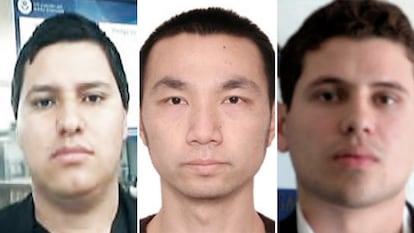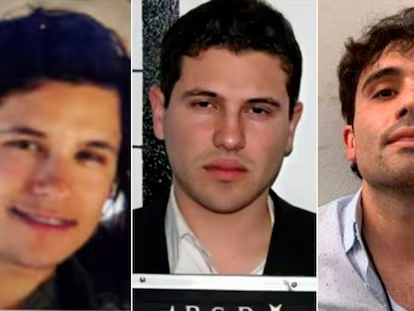Fentanyl crisis forces DEA to update most-wanted list
Historical capos — such as Ismael ‘El Mayo’ Zambada and Nemesio Oseguera Cervantes — have been relegated, as the U.S. Drug Enforcement Administration establishes new priorities


The fentanyl crisis in the United States has altered the list of the most-wanted criminals. The Drug Enforcement Administration (DEA) has dispensed with historical drug lords at the top of its list of fugitives. These positions have instead been filled by Mexican operators — who are helping the Sinaloa Cartel introduce fentanyl, the potent synthetic opioid, into the North American country — and by Chinese criminals shipping the substance from Asia. The DEA is particularly focused on the criminal group belonging to the sons of Joaquín El Chapo Guzmán, who are known in Mexico as “Los Chapitos.” El Chapo is currently serving a life sentence at a maximum security prison in Colorado.
At the head of the list is Óscar Noé Medina González, the right-hand man of Iván Archivaldo Guzmán Salazar, one of the sons of the jailed leader of the Sinaloa Cartel. According to the American government, Medina González — a seasoned hitman who goes by the nickname Panu — is charged with protecting the export routes of fentanyl, assassinating rivals from other organizations, expanding new drug-trafficking territory and coordinating attacks against the security forces. Washington is offering $4 million to anyone who can assist in his capture.
In second place is Kun Jiang, a Chinese citizen who supplies the Sinaloa Cartel with chemical precursors that are used in the clandestine manufacturing of fentanyl. Jiang — who has a million dollar reward hanging over his head — works at the pharmaceutical company Suzhou Xiaoli, a company that sent 25 kilos of chemical precursors to Guadalajara, Mexico, in September 2021. The illegal substances were then seized by Mexican officials. The DEA believes that the Sinaloa Cartel made the purchase.
Washington blames two large Mexican criminal organizations — the Sinaloa Cartel and the Jalisco Nueva Generación Cartel — for flooding dozens of communities with the powerful opioid. Los Chapitos, however, have questioned this accusation in a letter that was made public by their lawyers in May: “We have never worked with fentanyl,” they state in the document, where they claim that they are victims of persecution.
Fentanyl has caused an epidemic that, last year alone, left over 107,000 people dead from overdoses in the United States. In May, the DEA reported the results of a year-long operation that resulted in 3,330 detainees and the seizure of 44 million fentanyl pills, as well as two tons of precursors. This is enough to make fatal doses for 193 million people.
The DEA’s most-wanted list intends to target all angles of fentanyl trafficking, from its origin in China to the bosses who operate the routes that carry the drug into the United States. Following this transportation process, the doses are sold through traffickers, who are attached to local gangs.
One of the main traffickers on the list is Liborio Núñez Aguirre, known in the underworld as El Karateca. The karate fighter — who belongs to the Sinaloa Cartel — is one of the main fentanyl traffickers. He’s able to bring up to half-a-million doses into the country in just a single operation. Between March and April 2022, according to the authorities, he negotiated a shipment of 70,000 pills that belonged to Los Chapitos. These entered the U.S. through Oceanside, north of San Diego, where they were seized by DEA agents.
San Diego is a popular port of entry for traffickers. Luis Javier Benitez Espinoza — alias El Catorce — uses the city to introduce thousands of doses of the drug into the United States. The American government is offering a million dollars to anyone who provides information that leads to the arrest of Espinoza, who is also under the orders of Los Chapitos and appears on the DEA’s most-wanted list. The same is true of Alan Gabriel Núñez Herrera, who operates in the Los Angeles area.
Others on the list have already been captured, thanks to the extensive deployment of law enforcement agents by the United States to reduce the amount of drugs that reach American streets. One of those who have fallen is Carlos Omar Félix Gutiérrez, who operated the clandestine laboratories that the Sinaloa Cartel used to convert chemical precursors into fentanyl. Gutiérrez was detained in March of this year by Colombian authorities, just minutes after landing in Bogotá from Mexico. During that month, the DEA captured seven members of Los Chapitos in joint operations carried out in Guatemala and Greece.
The U.S. authorities affirm that Los Chapitos use social media as a tool to move drugs into American cities. “It’s alarming,” said Anne Milgram, the director of the DEA, this past May. “The cartels use these outlets and other encrypted platforms to conduct their operations and reach victims. When their products kill Americans, they just move on.” Among the social media sites used by traffickers are Facebook, Instagram, TikTok, Snapchat, WhatsApp, Telegram, Signal, Wire and Wickr.
The DEA’s most-wanted list is a reflection of the new era in the war on drugs. In the past, capos such as Ismael El Mayo Zambada — one of the old criminals from the Sinaloa Cartel — were the priority of U.S. agents. As was Nemesio Oseguera — known as El Mencho — the leader of the bloody cartel that operates in Jalisco and is responsible for much of the violence in that state and throughout western Mexico. These criminals haven’t left the list: they still appear among the 600 top targets for American law enforcement. But they have recently been displaced by a more urgent crisis.
Sign up for our weekly newsletter to get more English-language news coverage from EL PAÍS USA Edition
Tu suscripción se está usando en otro dispositivo
¿Quieres añadir otro usuario a tu suscripción?
Si continúas leyendo en este dispositivo, no se podrá leer en el otro.
FlechaTu suscripción se está usando en otro dispositivo y solo puedes acceder a EL PAÍS desde un dispositivo a la vez.
Si quieres compartir tu cuenta, cambia tu suscripción a la modalidad Premium, así podrás añadir otro usuario. Cada uno accederá con su propia cuenta de email, lo que os permitirá personalizar vuestra experiencia en EL PAÍS.
¿Tienes una suscripción de empresa? Accede aquí para contratar más cuentas.
En el caso de no saber quién está usando tu cuenta, te recomendamos cambiar tu contraseña aquí.
Si decides continuar compartiendo tu cuenta, este mensaje se mostrará en tu dispositivo y en el de la otra persona que está usando tu cuenta de forma indefinida, afectando a tu experiencia de lectura. Puedes consultar aquí los términos y condiciones de la suscripción digital.
More information
Archived In
Últimas noticias
Most viewed
- Sinaloa Cartel war is taking its toll on Los Chapitos
- Oona Chaplin: ‘I told James Cameron that I was living in a treehouse and starting a permaculture project with a friend’
- Reinhard Genzel, Nobel laureate in physics: ‘One-minute videos will never give you the truth’
- Why the price of coffee has skyrocketed: from Brazilian plantations to specialty coffee houses
- Silver prices are going crazy: This is what’s fueling the rally










































